The govt of Cumann na mBan in February, 1922. The creator's grandmother will be seen on the second row, third from the precise. UCD/Sighle Humphreys archives
The recollections I’ve of my paternal grandmother, Máirín Beaumont, largely contain sweets. She lived with me in Dublin till her demise in 1972, after I was 5. Our home, a protracted bungalow by the ocean, was divided in two with my grandmother dwelling within the high finish and my household (dad, mum and three sisters) occupying the underside finish.
I’d often flee to the highest finish to hunt refuge and luxury from my maimeó (Irish for granny) following some misdemeanour or an altercation with my older sisters. This resulted within the doling out of sugar cubes or butterscotch sweets from what appeared to be an infinite provide hidden away in her kitchen cabinets.
Following her demise I cherished these recollections. Her presence remained robust in our home as we had been surrounded by her furnishings, footage, books and the tokens handed on to us grandchildren as keepsakes (mine was a wood crocodile that sits on my desk at the moment).
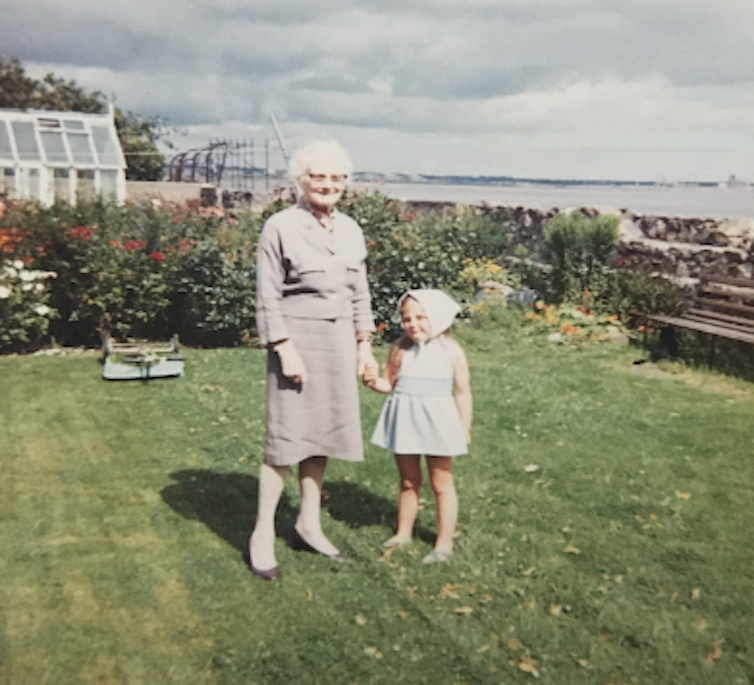
The creator along with her grandmother in 1971.
Caitriona Beaumont, Author supplied
Years later in 1988, after I was researching the historical past of the Irish girls’s motion throughout the Nineteen Twenties, Thirties and Nineteen Forties as a part of my MA in Modern Irish History at University College Dublin (UCD), I used to be stunned to find that in her later life my grandmother was a number one member of not one however two of the ladies’s organisations I used to be learning: the National University Women’ Graduates Association (NUWGA) and the Irish Countrywomen’s Association (ICA). As I combed via the UCD archives it was fantastic to recognise Máirín in {a photograph} of previous presidents of the Women Graduates Association, the place she had served as president from 1951-52.
But a a lot larger shock awaited me. Around 2016 my cousin shared one other picture with the household that belonged to his mom. Here, in a grainy sepia picture was my grandmother, in her early twenties, smiling straight on the digicam. She is perched on a bicycle holding a fishing rod in a single hand and a rifle within the different. The shock of seeing my maimeó, somebody I had at all times related to love and luxury, proudly brandishing a rifle and decked out in her Cumann na mBan (Women’s Council) uniform was profound. This wasn’t the grandmother I remembered.
Cumann na mBan was the Irish girls’s republican paramilitary organisation which was arrange in 1914, and from 1916 it was affiliated to the Irish Volunteers (later the Irish Republican Army, or IRA). I had been conscious Máirín was a member of it in her youth, however I knew little else. I learnt a bit extra after I contributed to the entry for my grandmother within the Dictionary of Irish Biography the place her involvement in Cumann na mBan is briefly talked about. Despite this public report, her help of nationalism – which advocated the usage of power – was not one thing we mentioned at dwelling. This was not an unusual expertise inside Irish households within the wake of the Irish Civil War (1922-23) and through The Troubles in Northern Ireland (1969-1998).
The state of affairs modified earlier this yr after I was requested to talk at a UCD symposium concerning the February 1922 Cumann na mBan conference that led to a spilt within the organisation between members who accepted, or rejected, the 1921 Anglo-Irish treaty. This was the treaty agreed between the British authorities and representatives of the brand new Irish Republic which led to an finish to the Irish War of Independence.
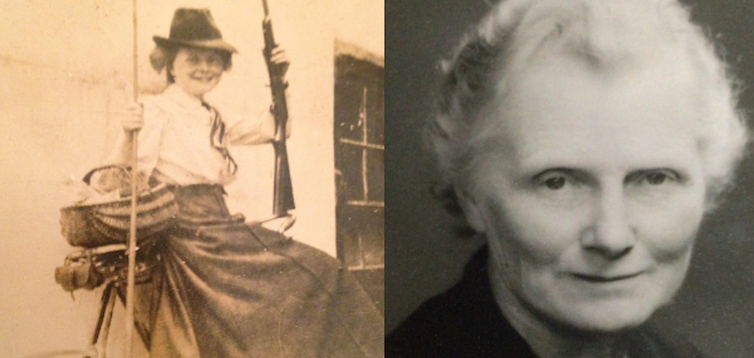
On the left Máirín Beaumont poses for an image in her Cumann na mBan uniform, subsequent to picture of her taken in 1954.
Caitriona Beaumont, Author supplied
The symposium was prompted by the Irish Government’s Decade of Centenaries programme which got down to “make sure that this advanced interval in our historical past, together with the battle for independence, the civil battle, the inspiration of the state, and partition is remembered appropriately, proportionately, respectfully and with sensitivity”. In this new context I felt it was the precise time to speak about my grandmother, her position in Cumann na mBan and the way she fared within the aftermath of the Irish Civil War. But I used to be in for an additional large shock.
Words from the previous
Deep within the digital archives of the National Library of Ireland I found that maimeó had spoken on the February 1922 conference of Cumann na mBan. None of the household had been conscious of this truth. As a member of its govt my grandmother, identified by her maiden title Máirín McGavock, made an impassioned speech rejecting the peace treaty with the British authorities. Here, Máirín informed fellow delegates that she couldn’t settle for the modification made by Jennie Wyse Power, founder member of Cumann na mBan, which acknowledged that the treaty “could be a giant step alongside the highway” to attaining a republic and that Cumann na mBan members ought to stay impartial and go away “it to the individuals to resolve the difficulty”.

This story is a part of Conversation Insights
The Insights workforce generates long-form journalism and is working with teachers from completely different backgrounds who’ve been engaged in tasks to deal with societal and scientific challenges.
Dismissing this compromise Máirín expressed her help for the decision put ahead by Mary MacSwiney that, “the chief of Cumann na mBan reaffirm its allegiance to the Republic of Ireland” and so rejects the treaty. Despite acknowledging that the treaty would carry a pause within the preventing she argued that, “we should always not get any respiration area if it means going into the British empire”, and went on to ask:
… are we to face tied whereas the lifetime of the nation we love is at stake? If we settle for this treaty we are going to by no means get a republic.
Reading these phrases it instantly dawned on me that my very own grandmother was one of many anti-treaty girls branded as “furies”, “die-hards” and “avid begetters of violence”, by politicians, the Catholic clergy and the press within the wake of the Irish civil battle.
Who had been the ‘die-hards’?
On January 1 1923 the president of the Irish Executive Council, William T Cosgrave, mirrored in his new yr’s day speech to the nation that:
… unhappily in Ireland the ‘die-hards’ are girls, whose ecstasies at their extremist can discover no outlet so satisfying as destruction – sheer destruction.
These phrases demonising republican girls who refused to simply accept the Anglo-Irish treaty and who supported the anti-treaty facet within the Irish civil battle, had been a standard function of political and public debate within the years following the institution of the Irish Free State. Sociologist Louise Ryan has written extensively concerning the destructive illustration of republican girls deemed to have picked the “incorrect” facet within the civil battle.
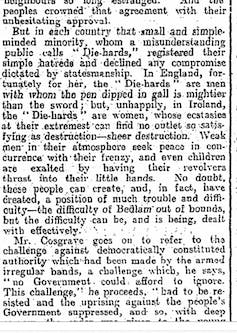
Part of William T Cosgrave’s speech revealed within the Irish Times in January 1923.
Irish Times
Embedded in these frequent expressions of nationalist rhetoric, a pre-requisite for nation constructing, girls who rejected the brand new Irish state had been labeled as transgressive and disorderly. Such destructive portrayals had been in sharp distinction to the popular and dominant illustration of Irish girls as respectable, regulation abiding wives and moms. It was these “true” Irish girls, in response to Ryan, who embodied the nation and acted as “the keepers of conventional tradition”.
The {photograph} of my grandmother holding a rifle, and her speech to the 1922 Cumann na mBan conference, strongly means that she too would have been seen as one in all these “disorderly girls” – somebody who was a risk to “social order and stability”.
Máirin’s witness assertion
Yet, extra revelations had been to observe. On May 10 1950 my grandmother gave a witness assertion to the Irish Bureau of Military History. The bureau was arrange in 1947 to collect main supply materials for the revolutionary interval from 1913 to 1921. In her witness assertion Máirín, then aged 56, gave a vivid account of her first encounter with the Irish Volunteers and her subsequent involvement with Cumann na mBan.
It is attention-grabbing that she agreed to offer a press release as many anti-treaty activists refused to have interaction with the bureau, concerning it as a “free state” mission. It can also be fascinating that she was snug documenting her help of physical-force nationalism whereas on the identical time taking over main roles within the NUWGA and the ICA. This suggests to me that she was pleased with her earlier actions as a member of Cumann na mBan and her help for the anti-treaty facet.
Reading her witness assertion, I wasn’t positive what to suppose when she recalled that in 1915, as a pupil dwelling at Dominican Hall, Dublin, she was requested to retailer two violin instances containing ammunition and revolvers for the Irish Volunteers.
We saved them in our room within the hostel for a while … they usually had been known as for simply earlier than we went dwelling for our Easter holidays, 1916.
The timing of this implies the arms had been used within the 1916 Easter Rising. To me this description of my grandmother storing arms was paying homage to a scene from a basic Hollywood gangster film – not one thing I ever imagined my maimeó to be doing.
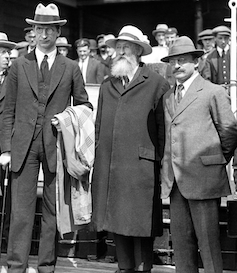
Eamon De Valera and his occasion having had profitable talks with the British authorities on the formation of an Irish Free State in 1921. From left to proper: Eamon De Valera, Count Plunkett and Arthur Griffiths.
PA Images / Alamy Stock Photo
Máirin stated that she was not in Dublin for the Easter Rising as she was spending her college vacation in Belfast. Returning to Dublin after the rising she joined a department of Cumann na mBan arrange in UCD and have become an lively member serving alongside roughly 75 different girls. Among the actions she participated in was fundraising for the households of these imprisoned for his or her position within the rising and visiting republican prisoners in Dublin. On one event she visited Count Plunkett, father of Joseph Plunkett, one of many executed leaders of the Easter Rising who had been incarcerated in Richmond Barracks, Dublin.
Like many members, Máirin was educated in first support and primary nursing abilities. She recounted how from October 1918:
…the unhealthy flu [the 1918 flu pandemic] raged so violently that nurses and docs had been scarce and Cumann na mBan supplied the companies of its members who had Red Cross coaching, as voluntary nurses.
She additionally famous that, “naturally there was no political distinction as regards the individuals we nursed”. The work was arduous with shifts within the evenings and in a single day. In specific my grandmother remembered being on responsibility the evening of November 11 1918 when the Armistice was signed marking the tip of the primary world battle. Violence broke out on the streets of Dublin when the Sinn Féin headquarters was attacked by British sympathisers, which should have been horrifying for the nurses on responsibility that evening.
Throughout 1919 and 1920, my grandmother recounted how she continued her “typical” Cumann na mBan actions: drilling (practising navy marches and manouvers), first support and home-nursing. Although she made no direct reference to the War of Independence she did point out that all through this time she was working as a trainer at Scoil Bhríde, “which was an incredible centre of political exercise and a gathering place for a lot of well-known republicans”. This included Ernest Blythe and Liam Mellows each lively members of the Irish Volunteers. Blythe went on to help the Anglo-Irish treaty and was later appointed as a authorities minister whereas Mellows opposed the treaty and was executed by firing squad in December 1922 for his half within the Irish civil battle.
Máirín described how dispatches had been left on the faculty “to be forwarded via city and nation by strains of communication organised by Cumann na mBan”, because the IRA management “discovered the submit totally unsafe” – little question as a result of British military interference. My grandmother defined how these communication strains “consisted of Cumann na mBan women strolling or biking from department to department within the cities and villages”.
In November 1920 Máirín was co-opted onto the chief committee of Cumann na mBan. As a youthful member of the chief she was anticipated at “weekends to carry district council conferences”. Recalling one such assembly, in Bruree, County Limerick, she highlighted the hardship endured throughout these journeys which, it should be remembered, passed off at a time of battle:
Sometimes we needed to spend nights with out sleep as we had been afraid or unable to get into accommodations.
Curfews which had been “imposed at a really early hour in some cities the place the IRA had been lively” made it much more troublesome for her and fellow organisers who had “in fact, to be again at our work on Monday mornings”.
My grandmother was additionally mixing with many main republican figures. In one other newly found household {photograph} my grandmother is among the company attending the August 22 1921 wedding ceremony of main IRA activist Tom Barry and Cumann na mBan govt member Leslie Price, at Vaughan’s Hotel, Dublin. This wedding ceremony {photograph} is a who’s who of Irish political life and my grandmother is sitting on the far left of the image. Among the company seen right here is Éamon De Valera, then president of the Dáil and Michael Collins who would lead the pro-treaty provisional authorities in 1922 earlier than being shot and killed by anti-treaty forces throughout the Irish civil battle.
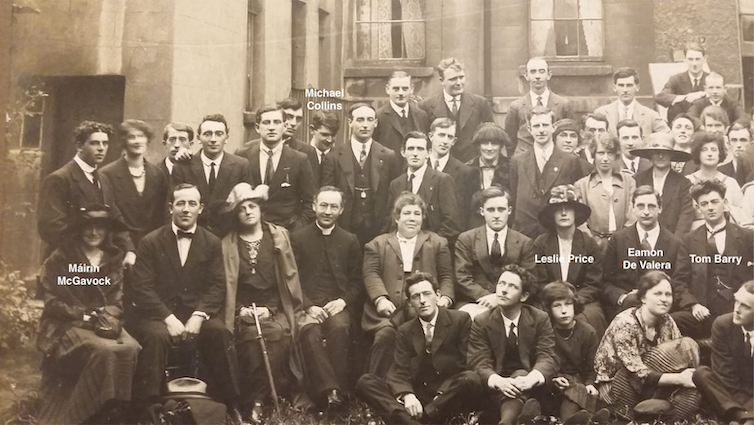
The creator’s grandmother pictured on the entrance row at wedding ceremony attended by Ireland’s most distinguished republican figures.
Caitriona Beaumont, Author supplied
Women’s rights
I discovered a 1921 pocket diary of my grandmother’s amongst her papers at our dwelling in Dublin that gives additional perception into her Cumann na mBan actions right now. For August 1921 (following the truce in hostilities) an entry signifies that she was travelling via the northern county of Tyrone holding what would seem like day by day recruitment conferences.
The agenda for these conferences outlined the fundamentals required to arrange a Cumann na mBan department. Key actions included: offering first support, area dressings, meals and secure homes for wounded combatants. “Discipline, punctuality, silence and braveness” had been listed as conditions for all new members.
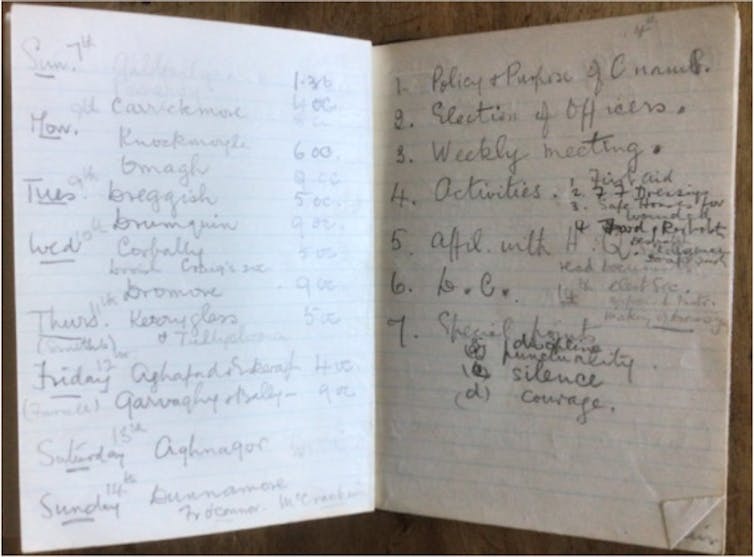
Máirín’s diary listed a few of her Cumann na mBan actions.
Caitriona Beaumont, Author supplied
Six months later it was as a member of the Cumann na mBan govt in 1922 that Máirín got here to offer her speech on the February conference. In confirming her rejection of the treaty she said:
I’m not an fanatic about girls’s rights however I imagine that girls have as a lot proper to declare their opinion as the lads have. We are an impartial physique of Irishwomen.
She claimed that Cumann na mBan was as entitled to have an opinion on the treaty because the Sinn Féin management and members of the Dáil (the Irish parliament). It is obvious from her phrases that she feared the views of Cumann na mBan had been being sidelined by these throughout the republican management and provisional authorities who supported the treaty. Despite her declare to not be captivated with girls’s rights she argued that, “girls got here via issues that had been maybe as nice, or higher, than the lads”, and so had been “entitled to declare our opinion”.
As a feminist historian studying these phrases I’m in little question that my grandmother was absolutely cognisant of makes an attempt to “silence” girls in public life. Although many could disagree along with her stance on the treaty and her willingness to have interaction in additional hostility, I’m proud that she wished to defend the precise of ladies to precise their views, whatever the dangers concerned, on the way forward for the Irish nation.
The Irish Free State
Máirín’s beliefs, and the stand she was taking, additionally should be understood within the context of the time. The Irish Free State was born out of violence, division and turmoil. The island of Ireland had been underneath British colonial rule for over 800 years, punctuated by a lot of makes an attempt – political and revolutionary – to interrupt free from British management. The failed 1916 Easter Rising (an armed rebel towards British rule) and subsequent execution of its leaders, reignited calls for for an impartial Ireland, freed from all ties to the United Kingdom and the British empire.
The half performed by Cumann na mBan within the Easter Rebellion was important. This went past the actions of a lot of now very well-known girls. Included on this choose group is Constance Markievicz, who in 1918 grew to become the primary lady elected as a Member of Parliament to Westminster, though as a republican she refused to take her seat. Historians Margaret Ward, Sínead McCoole, Cal McCarthy and Mary McAuliffe, amongst others, have shared the tales and documented the experiences of round 200 “peculiar” girls who took half within the rising.
They got here from completely different walks of life and included lecturers, nurses, college students, commerce unionists, feminist activists and manufacturing facility employees. These girls had been lively in roles as various as snipers, cooks, first-aiders and couriers. After six days of fierce preventing the Easter Rising was suppressed, leaving some 500 useless and Dublin metropolis centre in ruins.
Three years after the rising violence erupted as soon as once more with the outbreak of the Irish War of Independence (1919-1921). The rising reputation of Sinn Féin, a radical political occasion calling for full Irish independence, culminated in its profitable 73 out of 105 seats for Ireland, within the UK’s December 1918 normal election.
Read extra:
Sinn Féin’s sudden rise to energy in 1918 was lengthy seen as a ‘youthquake’ – now there is a completely different rationalization
Cumann na mBan was instrumental in supporting this election victory with members canvassing regionally for Sinn Féin candidates, together with my grandmother who supported the election marketing campaign of Sinn Féin member Desmond FitzGerald, who was elected MP for the Dublin Pembroke constituency. The success of Sinn Féin, and the shock defeat of the extra average Irish Parliamentary Party, who supported devolved authorities (dwelling rule) for Ireland, marked a step change in Irish politics and Anglo-Irish relations.
From 1919 to 1921 a guerrilla battle was waged throughout Ireland. Atrocities had been dedicated on each side with an estimated 2,000 deaths.
Just as that they had carried out in 1916, Cumann na mBan members performed an lively position, and risked their lives, in supporting republican forces throughout the War of Independence. Across the nation, girls supplied a community of secure homes for IRA males on the run from British forces and acted as intelligence brokers and messengers, enabling the sharing of navy info between IRA items. One main member, Kathleen Clarke, recounted how she smuggled £2,000 of gold, strapped about her physique, from Limerick to Dublin, thereby avoiding discovery at British checkpoints alongside the best way.
The War of Independence led to a truce in July 1921, adopted by the signing of the Anglo-Irish treaty in December that yr. Under the phrases of the treaty a 26-county Irish Free State could be established as a self-governing dominion throughout the British empire. The six-county unionist majority (representing Protestant pursuits) Northern Ireland State, which remained a part of the UK, was additionally established with its personal devolved authorities sitting in Stormont, Belfast.
On January 7 1922 the Irish parliament voted to approve the treaty by a slim majority. Taking a professional or anti-treaty stance cut up the ruling Sinn Féin occasion. This resulted within the pro-treaty provisional authorities, led by Michael Collins, being in direct opposition with members of its navy wing, the IRA. Civil battle adopted with two additional years of violence and the creation of divisions inside Irish households, communities and political life that proceed to resonate at the moment.
‘Sister towards sister’
Another {photograph} was to provide a remaining shock about Máirín. It was taken on February 5 1922, 4 weeks after the Anglo-Irish treaty was formally accredited, when Cumann na mBan known as a particular conference to debate the phrases.
The picture is of the chief committee and reveals my grandmother standing within the second row, three from the precise, with Constance Markievicz, Mary MacSwiney and Jennie Wyse Power sitting within the entrance row. I had seen this picture earlier than and was satisfied the lady whose face was shadowed by the massive hat was my grandmother. But I couldn’t be certain till my cousin discovered Máirín’s personal copy amongst a stack of previous household pictures. On the again, she had written out who was who, together with herself. I used to be delighted that I had recognised her.
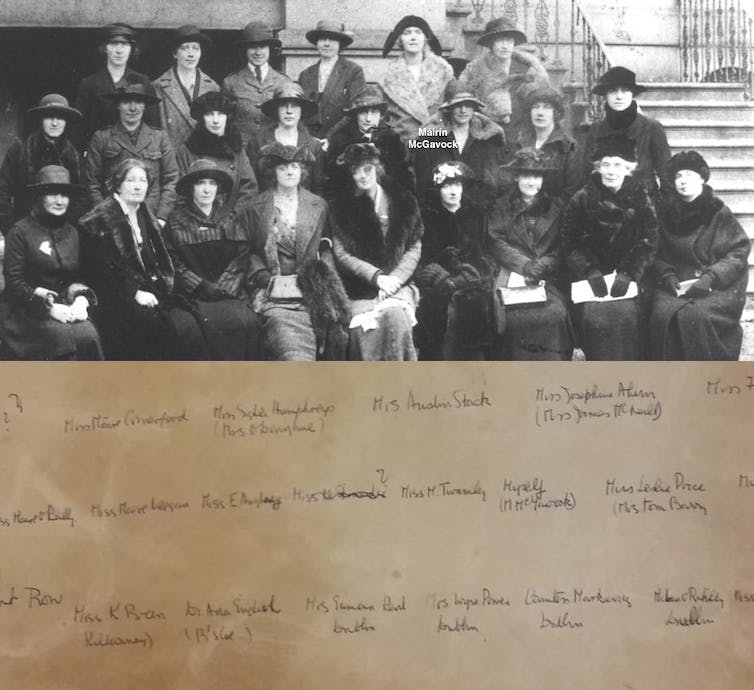
Mairin Beaumont (McGavock) on the 1922 Cumann na mBan conference and beneath her personal writing on the again of the picture.
Caitriona Beaumont/UCD archives
Around 600 girls attended the assembly. Following a debate, throughout which my grandmother spoke, the chief confirmed its anti-treaty stance and its allegiance to the Republic of Ireland. Leading pro-treaty members, together with Power, then cut up from Cumann na mBan and in March 1922 established a brand new organisation, Cumann na Saoirse (The League for Freedom).
The Irish Civil War raged on till mid-1923 with a repetition of the guerrilla techniques seen throughout the War of Independence. Former allies discovered themselves on reverse sides and distinguished leaders had been killed or executed, together with Michael Collins. In May the anti-treaty IRA agreed to a ceasefire with its fighters returning dwelling.
As John Borgonovo, lecturer in historical past at University College Cork, has documented, members of Cumann na mBan had been lively all through the civil battle and had been built-in with republican forces across the nation. Members established kitchens and first support dressing stations and in additional rural areas acted as look-outs and carried messages and provides throughout the preventing.
Borgonovo argues that many members who discovered themselves on the dropping facet within the civil battle “transitioned to non-violent opposition within the free state”, joined formal political events or moved “to completely different types of agitation or civil engagement” with others “withdrawing from public life altogether”.
Contribution to society
Back in 1988 after I uncovered her roles within the NUWGA and the ICA, I used to be excited and pleased with the truth that Máirín had joined organisations searching for to reinforce the lives of ladies and women.
Máirín was born on December 7 1894 in Glenarm, County Antrim, one in all 4 daughters of William and Annie McGavock. She was educated on the Catholic Dominican College, Dublin, after which enrolled on the BA Languages Degree at UCD. She was awarded her BA in 1915 adopted by an MA in German in 1916. In 1917 she graduated with the next diploma in training. That identical yr, she joined the founding employees as a trainer at Scoil Bhríde, an Irish language secondary faculty for ladies in Dublin.
Throughout her life my grandmother remained dedicated to her twin passions: training and Irish language and literature. As a fluent Irish speaker she was passionate concerning the language and its significance in safeguarding Irish tradition and identification. She remained lively in training into center age in her position as an exterior examiner in training for the National University of Ireland.
Frustratingly I haven’t but been capable of finding any sources indicating what my grandmother was doing throughout the Irish Civil War. What I do know is that in 1923 she married my grandfather, Sean Beaumont, a lecturer and founding father of An t-Éireannach newspaper they usually went on to have three kids, Máire in 1925, Helen in 1927, and my dad Piaras in 1933. She continued to work as an exterior examiner following the beginning of her kids and on the identical time grew to become lively in a lot of civil society associations, together with the Dublin Playgrounds Committee which oversaw the availability of kid steering, dwelling visiting, playgrounds and nurseries to much less well-off households.
I used to be thrilled to study that within the Nineteen Fifties she was elected president of the NUWGA, following within the footsteps of serious Irish girls together with: Alice Oldham, and professors Mary Hayden, Agnes O’Farrelly and Mary Macken. From the Nineteen Twenties the NUWGA participated in a lot of excessive profile campaigns to safeguard the rights of ladies. This included protesting towards a wedding bar, which compelled girls to resign their jobs on getting married, defending the precise of ladies to serve on juries and campaigning towards discriminatory gender clauses within the draft 1937 Irish Constitution.
Having the chance to analysis the life story of my grandmother has remodeled how I take into consideration her, and the opposite girls branded as furies and die-hards. Regardless of the destructive portrayals, my grandmother did make a big and significant contribution to Irish society.
The younger lady smiling out at me from that previous {photograph}, absolutely dedicated to the struggle for an impartial Ireland, survived the turmoil of the revolutionary interval. She went on to make her mark within the new Irish state via her position as a housewife, trainer, activist and promoter of the Irish language. She did this regardless of being on the “dropping facet” and sustaining her life lengthy objection to the Anglo-Irish treaty.
I now have a significantly better understanding of my grandmother and really feel a lot extra related to her. It is superb that she was part of the histories of feminine activism I’ve been researching and writing about for the previous 34 years. The success of the Decade of Centenaries is making area for all of the histories of the Irish revolution. This ensures we keep in mind everybody who has contributed, together with the ladies branded as furies and the die-hards.

For you: extra from our Insights collection:
Climate scientists: idea of internet zero is a harmful entice
Sexual exploitation by UN peacekeepers in DRC: fatherless kids communicate for first time concerning the ache of being deserted
The public value of personal faculties: rising charges and luxurious amenities elevate questions on charitable standing
To hear about new Insights articles, be a part of the a whole bunch of hundreds of people that worth The Conversation’s evidence-based information. Subscribe to our publication.
![]()
Caitriona Beaumont doesn’t work for, seek the advice of, personal shares in or obtain funding from any firm or organisation that will profit from this text, and has disclosed no related affiliations past their tutorial appointment.
